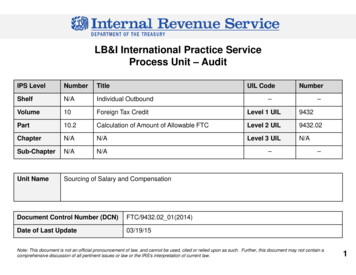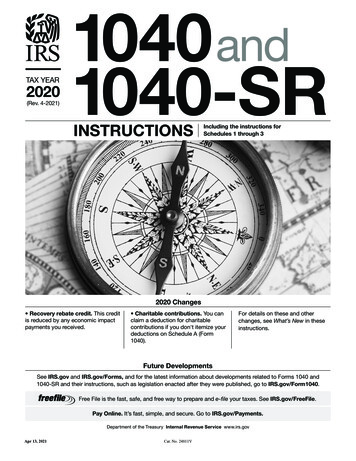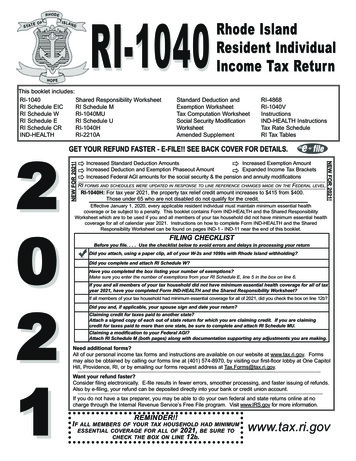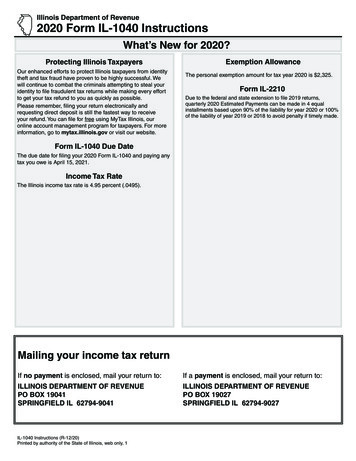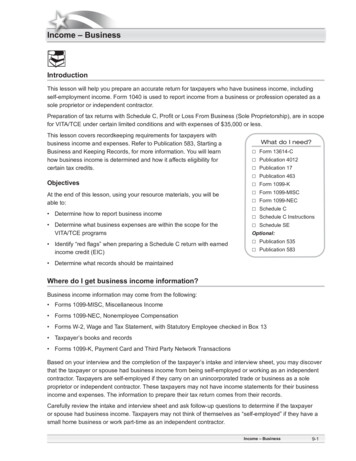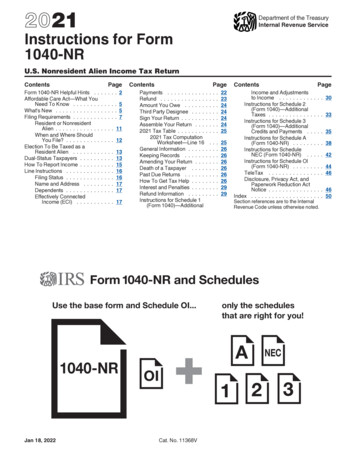
Transcription
2021Department of the TreasuryInternal Revenue ServiceInstructions for Form1040-NRU.S. Nonresident Alien Income Tax ReturnContentsForm 1040-NR Helpful Hints . .Affordable Care Act—What YouNeed To Know . . . . . . . .What's New . . . . . . . . . . . . .Filing Requirements . . . . . . . .Resident or NonresidentAlien . . . . . . . . . . . . .When and Where ShouldYou File? . . . . . . . . . .Election To Be Taxed as aResident Alien . . . . . . . .Dual-Status Taxpayers . . . . . .How To Report Income . . . . . .Line Instructions . . . . . . . . . .Filing Status . . . . . . . . . .Name and Address . . . . .Dependents . . . . . . . . . .Effectively ConnectedIncome (ECI) . . . . . . .Page. 2. 5. 5. 7. . . . 11. . . . 12.13131516161717. . . . 17ContentsPayments . . . . . . . . . . .Refund . . . . . . . . . . . . .Amount You Owe . . . . . .Third Party Designee . . . .Sign Your Return . . . . . . .Assemble Your Return . . .2021 Tax Table . . . . . . . .2021 Tax ComputationWorksheet—Line 16General Information . . . . .Keeping Records . . . . . .Amending Your Return . . .Death of a Taxpayer . . . .Past Due Returns . . . . . .How To Get Tax Help . . . .Interest and Penalties . . . .Refund Information . . . . .Instructions for Schedule 1(Form 6262929ContentsIncome and Adjustmentsto Income . . . . . . . . . .Instructions for Schedule 2(Form 1040)—AdditionalTaxes . . . . . . . . . . . . .Instructions for Schedule 3(Form 1040)—AdditionalCredits and Payments . .Instructions for Schedule A(Form 1040-NR) . . . . . .Instructions for ScheduleNEC (Form 1040-NR) . .Instructions for Schedule OI(Form 1040-NR) . . . . . .TeleTax . . . . . . . . . . . . .Disclosure, Privacy Act, andPaperwork Reduction ActNotice . . . . . . . . . . . . .Index . . . . . . . . . . . . . . . . . .1040-NRJan 18, 2022only the schedulesthat are right for you!AOICat. No. 11368V. . . 30. . . 33. . . 35. . . 38. . . 42. . . 44. . . 46. . . 46. . . 50Section references are to the InternalRevenue Code unless otherwise noted.Form 1040-NR and SchedulesUse the base form and Schedule OI.PageNEC
Form 1040-NR Helpful HintsThe lines on Form 1040-NR are arranged so that, in most instances, they are for the same tax items as the lines on 2021 Forms 1040 and 1040-SR.You may also need the three Form 1040 numbered schedules: Schedule 1 (Form 1040), Additional Income and Adjustments to Income; Schedule 2 (Form1040), Additional Taxes; and Schedule 3 (Form 1040), Additional Credits and Payments.You will need to complete the applicable items on Schedule OI (Form 1040-NR) and include that schedule with your Form 1040-NR.CAUTION: There are a Schedule A (Form 1040-NR) and a Schedule A (Form 1040). Do not use Schedule A (Form 1040-NR) with Form 1040 or Form1040-SR. Use Schedule A (Form 1040-NR) only with Form 1040-NR. If using a Schedule A with Form 1040 or 1040-SR, use Schedule A (Form 1040).Though you will need to file Form 1040-NR and Schedule OI (Form 1040-NR), you may not need to file the numbered schedules (Schedules 1 through 3(Form 1040)), or Schedule A (Form 1040-NR) and Schedule NEC (Form 1040-NR). However, if your return is more complicated (for example, you claimcertain deductions or credits or owe additional taxes, or you have U.S. source income not effectively connected with a U.S. trade or business), you will need tocomplete one or more of those schedules. Below is a general guide to which schedule(s) you will need to file based on your circumstances. See theinstructions for the schedules later for more information. If you e-file your return, you generally will not notice much of a change and the software you use willgenerally determine which schedules you need.You will need the Instructions for Form 1040. Throughout these instructions, you are directed to go to the Instructions for Forms 1040 (also known as theInstructions for Form 1040 (and 1040-SR)) for details on how to complete a line. But, in most instances, you will need to look at whether you must takeexceptions into consideration when applying those instructions. The specific exceptions for a line are listed under the instructions for the line. Some of theexceptions noted repeatedly in the line instructions are below. A nonresident alien filing Form 1040-NR cannot have a Married filing jointly or a Head of household filing status. Certain tax benefits (such as the child tax credit, the credit for other dependents, and the additional child tax credit; and the premium tax credit fordependents) are only available in full to residents of Canada and Mexico and, to a limited extent, to residents of India and South Korea. These tax benefitscannot be claimed by other nonresident aliens. There are certain forms used by Form 1040 and Form 1040-SR filers that are NOT used by Form 1040-NR filers: for example, Form 2555, Form 965, andSchedule K-1 (Form 1120-S). The instructions for estates and trusts on the main form may, in certain instances, align more with the Instructions for Form 1041, U.S. Income Tax Returnfor Estates and Trusts, than with the Instructions for Form 1040, which are for individuals. If you are filing for a nonresident alien estate or trust, you will stillneed to follow the Instructions for Schedule NEC, later, if the estate or trust has U.S. source income that is not effectively connected with a U.S. trade orbusiness. And there may be tax benefits and income inclusions on Form 1041 not applicable to a nonresident alien trust or estate.IF YOU . . .THEN USE . . .Can claim deductions and losses properly allocated and apportioned to income effectively connected with Schedule A (Form 1040-NR)a U.S. trade or business. Do not include deductions and/or losses that relate to exempt income or toNote. Do not use Schedule A (Form 1040-NR)income that is not effectively connected with a U.S. trade or business.with Form 1040 or Form 1040-SR. UseSchedule A (Form 1040-NR) only with Form1040-NR. With Form 1040 or 1040-SR, useSchedule A (Form 1040).Have income not effectively connected with a U.S. trade or business.Schedule NEC (Form 1040-NR)Have additional income, such as business or farm income or loss, unemployment compensation, prize oraward money, or gambling winnings from a U.S. trade or business.Schedule 1 (Form 1040), Part IHave any deductions to claim, such as student loan interest deduction, self-employment tax, or educatorexpenses.Schedule 1 (Form 1040), Part IIOwe alternative minimum tax (AMT) or need to make an excess advance premium tax credit repayment.Schedule 2 (Form 1040), Part IOwe other taxes, such as self-employment tax, household employment taxes, and additional tax on IRAsor other qualified retirement plans and tax-favored accounts.Schedule 2 (Form 1040), Part IICan claim a nonrefundable credit (other than the nonrefundable child tax credit or the credit for otherdependents), such as the foreign tax credit or general business credit.Schedule 3 (Form 1040), Part ICan claim a refundable credit (other than the refundable child tax credit or additional child tax credit), suchas the net premium tax credit, health coverage tax credit, or qualified sick and family leave credits fromSchedule H or Schedule SE.Schedule 3 (Form 1040), Part IIHave other payments, such as an amount paid with a request for an extension to file or excess socialsecurity tax withheld.-2-Instructions for Form 1040-NR (2021)
The Taxpayer Advocate Service (TAS) Is Here To Help YouWhat is the Taxpayer Advocate Service?The Taxpayer Advocate Service (TAS) is an independent organization within the IRS that helps taxpayers and protectstaxpayer rights. Their job is to ensure that every taxpayer is treated fairly and that you know and understand your rightsunder the Taxpayer Bill of Rights.How can you learn about your taxpayer rights?The Taxpayer Bill of Rights describes 10 basic rights that all taxpayers have when dealing with the IRS. Go toTaxpayerAdvocate.IRS.gov to help you understand what these rights mean to you and how they apply. These are yourrights. Know them. Use them.What can TAS do for you?TAS can help you resolve problems that you can’t resolve with the IRS. And their service is free. If you qualify for theirassistance, you will be assigned to one advocate who will work with you throughout the process and will do everythingpossible to resolve your issue. TAS can help you if: Your problem is causing financial difficulty for you, your family, or your business; You face (or your business is facing) an immediate threat of adverse action; or You have tried repeatedly to contact the IRS but no one has responded, or the IRS has not responded by the datepromised.How can you reach TAS?TAS has offices in every state, the District of Columbia, and Puerto Rico. Your local advocate’s number is in your localdirectory at TaxpayerAdvocate.IRS.gov/Contact-Us. You can also call them at 877-777-4778.How else does TAS help taxpayers?TAS works to resolve large-scale problems that affect many taxpayers. If you know of one of these broad issues, pleasereport it to them at IRS.gov/SAMS.TAS for Tax ProfessionalsTAS can provide a variety of information for tax professionals, including tax law updates and guidance, TAS programs, andways to let TAS know about systemic problems you’ve seen in your practice.Low Income Taxpayer Clinics (LITCs)Low Income Taxpayer Clinics (LITCs) are independent from the IRS. LITCs represent individuals whose income is below acertain level and need to resolve tax problems with the IRS, such as audits, appeals, and tax collection disputes. In addition,LITCs can provide information about taxpayer rights and responsibilities in different languages for individuals who speakEnglish as a second language. Services are offered for free or a small fee for eligible taxpayers. To find an LITC near you,visit TaxpayerAdvocate.IRS.gov/about/LITC or see IRS Pub. 4134, Low Income Taxpayer Clinic List.Suggestions for Improving the IRSTaxpayer Advocacy PanelHave a suggestion for improving the IRS and do not know who to contact? The Taxpayer Advocacy Panel (TAP) is a diversegroup of citizen volunteers who listen to taxpayers, identify taxpayers’ issues, and make suggestions for improving IRSservice and customer satisfaction. The panel is demographically and geographically diverse, with at least one member fromeach state, the District of Columbia, and Puerto Rico. Contact TAP at ImproveIRS.org or 888-912-1227 (toll free).Instructions for Form 1040-NR (2021)-3-
You can electronically file (e-file) your Form 1040-NR.Options for e-filing your returns—safely, quickly, and easilyWhy do 89% of Americans file their taxes electronically? Security—The IRS uses the latest encryption technology to safeguard your information. Flexible Payments—File early; pay by the due date of your return (not countingextensions)—April 18, 2022 (for most people). Greater Accuracy—Fewer errors mean faster processing. Quick Receipt—Get an acknowledgment that your return was received and accepted. Go Green—Reduce the amount of paper used. Faster Refunds—Join the eight in 10 taxpayers who get theirrefunds faster by using direct deposit and e-file.IRS e-file: It’s Safe.It’s Easy. It’s Time.Joining the more than 135 million Americans who are already using e-file is easy. Just ask your tax preparer oruse commercial software. IRS e-file is the safest, most secure way to transmit your tax return to the IRS. Since1990, the IRS has processed more than 1 billion e-filed tax returns safely and securely. There’s no paper returnto be lost or stolen.Most tax return preparers are now required to use IRS e-file. If you are asked if you want to e-file, just give it a try.IRS e-file is now the norm, not the exception.IRS.gov is the gateway to all electronic services offered by the IRS, as well as the spot to download forms atIRS.gov/Forms.Make your tax payments electronically—it’s easy.You can make electronic payments online, by phone, or from a mobile device. Paying electronicallyis safe and secure. It puts you in control of paying your tax bill and gives you peace of mind. Youdetermine the payment date, and you will receive an immediate confirmation from the IRS. It’s fast,simple, and secure. Go to IRS.gov/Payments to see all your electronic payment options.-4-Instructions for Form 1040-NR (2021)
Affordable Care Act—WhatYou Need To KnowSee Affordable Care Act—What YouNeed To Know in the Instructions forForm 1040 for details.Future developments. For the latestinformation about developmentsrelated to Form 1040-NR and itsinstructions, such as legislationenacted after they were published, goto IRS.gov/Form1040NR.What's NewQualified disability trusts. Theexemption amount for a qualifieddisability remains at 4,300 for 2021.Charitable contributions. Studentsor business apprentices eligible forthe benefits of Article 21(2) of theUnited States-India Income TaxTreaty who have elected to use thestandard deduction may qualify totake a deduction for charitable cashcontributions of up to 300 for the2021 tax year. See Line 12b, later.Due date of return. File Form1040-NR by April 18, 2022, if youwere an employee and receivedwages subject to U.S. income taxwithholding. The due date is April 18,instead of April 15, because of theEmancipation Day holiday in theDistrict of Columbia—even if you don'tlive in the District of Columbia.Virtual currency. If, in 2021, youengaged in a transaction involvingvirtual currency, you will need toanswer "Yes" to the question onpage 1 of Form 1040-NR. See VirtualCurrency in the Instructions for Form1040 for information on transactionsinvolving virtual currency. Do notleave this field blank. The questionmust be answered by all taxpayers,not just taxpayers who engaged in atransaction involving virtual currency.Credits for sick and family leavefor certain self-employed individuals. The Families First CoronavirusResponse Act (FFCRA) helpedself-employed individuals affected bycoronavirus by providing paid sickleave and paid family leave creditsequivalent to those that employers arerequired to provide their employeesfor qualified sick leave wages andqualified family leave wages. TheCOVID-related Tax Relief Act of 2020extended the period during whichindividuals can claim these credits.Instructions for Form 1040-NR (2021)For more information, see theinstructions for Form 7202 andSchedule 3, Line 13b.Extension and expansion of credits for sick and family leave. TheAmerican Rescue Plan Act of 2021,enacted on March 11, 2021 (ARP)provides that certain self-employedindividuals can claim credits for up to10 days of “paid sick leave,” and up to60 days of “paid family leave,” if theyare unable to work or telework due tocircumstances related to coronavirus.Self-employed individuals may claimthese credits for the period beginningon April 1, 2021, and endingSeptember 30, 2021. For moreinformation, see the instructions forForm 7202 (and Schedule 3,Line 13h, later).Form 9000, Alternative Media Preference. Beginning in 2021,taxpayers with print disabilities canuse Form 9000, Alternative MediaPreference, to elect to receive noticesfrom the IRS in an alternative formatincluding Braille, large print, audio,and electronic. You can attach Form9000 to your Form 1040-NR or youcan mail it separately. For moreinformation, see Form 9000.All taxpayers now eligible for Identity Protection PIN. Beginning in2021, the IRS Identity Protection PIN(IP PIN) Opt-In Program has beenexpanded to all taxpayers who canproperly verify their identity. An IP PINhelps prevent your social securitynumber from being used to file afraudulent federal income tax return.You can use the Get An IP PIN tool onIRS.gov to request an IP PIN, fileForm 15227 if your income is 72,000or less, or make an appointment tovisit a Taxpayer Assistance Center.Direct deposit now available for returns filed late. You can nowreceive a direct deposit of your refundeven if you file your 2021 return afterNovember 30, 2022.Expanded dependent care assistance. ARP expanded the child anddependent care tax credit for 2021 bymaking it refundable for certaintaxpayers and making it larger. For2021, the dollar limit on qualifyingexpenses increases to 8,000 for onequalifying person and 16,000 for twoor more qualifying persons. The rulesfor calculating the credit have alsochanged; the percentage of qualifying-5-expenses eligible for the credit hasincreased, along with the income limitat which the credit begins phasingout. Additionally, for taxpayers whoreceive dependent care benefits fromtheir employer, the dollar limit of theexclusion amount increases for 2021.For more information, see theInstructions for Form 2441 and Pub.503.Child tax credit. Under ARP, thechild tax credit has been enhanced for2021. The child tax credit has beenextended to qualifying children underage 18. Depending on modifiedadjusted gross income, you mayreceive an enhanced credit amount ofup to 3,600 for a qualifying childunder age 6 and up to 3,000 for aqualifying child over age 5 and underage 18. The enhanced credit amountbegins to phase out where modifiedadjusted gross income exceeds 150,000 in the case of a qualifyingwidow(er) and 75,000 in all othercases. But see the exceptions inLine 19, later, for Form 1040-NR filers.If you lived in the United States formore than half the year, the child taxcredit will be fully refundable even ifyou don't have earned income. Seethe exception in Line 28, later, formore details. If you don't meet thisresidency requirement, your child taxcredit will be a combination of anonrefundable child tax credit and arefundable additional child tax credit,as was the case in 2020. The creditfor other dependents has not beenenhanced and is figured as it was in2020.Changes to Schedule 8812 (Form1040). Because of the changesmade by ARP, detailed discussion ofthe child tax credit, and how to figureyour child tax credit and credit forother dependents, which werepreviously part of the Instructions forForm 1040 has been moved to theInstructions for Schedule 8812 (Form1040). If you are claiming thenonrefundable child tax credit,refundable child tax credit, additionalchild tax credit, or credit for otherdependents, complete Schedule 8812(Form 1040) and attach it to yourForm 1040-NR. But see theexceptions in Line 19 and Line 28,later, for more details.Premium tax credit (PTC). ARPexpanded the PTC by eliminating thelimitation that a taxpayer's household
income may not exceed 400% of theFederal Poverty Line and generallyincreases the credit amounts. Inaddition, in 2021, if you receiveunemployment compensation, youare generally eligible to claim the PTCif you meet the other requirements.For more information, see Pub. 974and Form 8962 and its instructions.But see the exception in Line 9, later,for more details.Forgiveness of Paycheck Protection Program (PPP) Loans. Theforgiveness of a PPP Loan createstax-exempt income, so you don't needto report the income on Form1040-NR, but you do need to reportcertain information related to yourPPP Loan. To find out how to reportinformation related to your Loan, seeForgiveness of Paycheck ProtectionProgram (PPP) Loans, under Income,in the Instructions for Form 1040.Identity verification. The IRSlaunched an improved identityverification and sign-in process thatenables more people to securelyaccess and use IRS online tools andapplications. To provide verificationservices, the IRS is using ID.me, atrusted technology provider. The newprocess is one more step the IRS istaking to ensure that taxpayerinformation is provided only to theperson who legally has a right to thedata. Taxpayers using the newmobile-friendly verification procedurecan gain entry to existing IRS onlineservices such as the Child Tax CreditUpdate Portal, Online Account, GetTranscript Online, Get an IdentityProtection PIN (IP PIN), and OnlinePayment Agreement. Additional IRSapplications will transition to the newmethod over the next year. Eachonline service will also provideinformation that will instruct taxpayerson the steps they need to follow foraccess to the service. You can alsosee IR-2021-228 for more information.RemindersMarried filing status. At the top ofpage 1 of Form 1040-NR, select thefiling status Married filing separately ifyou are married even if you are notseparated from your spouse. But seeMarried Filing Separately, later, for anexception.-6-Form 1040-NR. Refer to Form1040-NR Helpful Hints, earlier, for acomprehensive discussion of theseinstructions, including the referencesto the Instructions for Form 1040 thatyou see throughout these instructions.Required e-filing. Tax returnpreparers must generally e-file Forms1040-NR for tax returns filed for taxyears ending on or after December31, 2020, unless filing for a dual statustaxpayer, a fiscal-year taxpayer, atrust, or an estate. For these and otherexceptions, see Notice 2020-70.Deductible IRA contributions. Youno longer need to be younger thanage 701/2 to take a deduction for yourcontributions to an IRA.Schedule LEP (Form 1040), Request for Change in LanguagePreference. Schedule LEP allowstaxpayers to state a preference toreceive written communications fromthe IRS in a language other thanEnglish. For more information,including which languages areavailable and how to file, seeSchedule LEP.Instructions for Form 1040-NR (2021)
Filing RequirementsDo You Have To File?File Form 1040-NR if any of theconditions in Table A. Who Must FileForm 1040-NR, later, apply to you.!CAUTIONYou must still meet (1), (2), or(3) below to be exempt fromfiling a 2021 Form 1040-NR.Exceptions. You do not need to fileForm 1040-NR if you meet (1), (2), or(3) below.1. You were a nonresident alienstudent, teacher, or trainee who wastemporarily present in the UnitedStates under an “F,” “J,” “M,” or “Q”visa, and you have no income that issubject to tax under section 871 (thatis, the income items listed on page 1of Form 1040-NR, lines 1a, 1b, 2b, 3b,4b, 5b, 7, and 8, and Schedule NEC(Form 1040-NR), lines 1 through 12).2. You were a student or businessapprentice who was eligible for theInstructions for Form 1040-NR (2021)benefits of Article 21(2) of the UnitedStates-India Income Tax Treaty, youare single or a qualifying widow(er),and your gross income for 2021 wasless than or equal to 12,550 if single( 25,100 if a qualifying widow(er)).See chapter 5 of Pub. 519 for moredetails on these treaty benefits.3. You were a partner in a U.S.partnership that was not engaged in atrade or business in the United Statesduring 2021 and your Schedule K-1(Form 1065) includes only incomefrom U.S. sources reportable onSchedule NEC (Form 1040-NR), lines1 through 12.If the partnership withholdstaxes on this income in 2022CAUTION and the tax withheld andreported in box 10 of Form 1042-S isless or more than the tax due on theincome, you will need to file Form1040-NR for 2022 to pay theunderwithheld tax or claim a refund ofthe overwithheld tax.!-7-Even if you do not otherwiseTIP have to file a return, youshould file one if you can getmoney back. For example, you shouldfile if one of the following applies.1. You are eligible to get a refundof any federal income tax withheld.2. You are engaged in a U.S. tradeor business and are eligible for any ofthe following credits.a. Additional child tax credit.b. Credit for federal tax on fuels.c. Premium tax credit.d. Health coverage tax credit.e. Refundable child tax credit.f. Refundable child anddependent care expenses.You should also consider filing areturn if you received a Form 1099-B(or substitute statement). See Pub.501 for more details.
Table A. Who Must File Form 1040-NRYou must file Form 1040-NR if any of the following conditions apply to you.1. You were a nonresident alien engaged in a trade or business in the United States during 2021. You must file even if:a. You have no income from a trade or business conducted in the United States,b. You have no U.S. source income, orc. Your income is exempt from U.S. tax under a tax treaty or any section of the Internal Revenue Code.However, if you have no gross income* for 2021, do not complete the schedules for Form 1040-NR other than Schedule OI (Form 1040-NR).Instead, attach a list of the kinds of exclusions you claim and the amount of each.2. You were a nonresident alien not engaged in a trade or business in the United States during 2021 and:a. You received income from U.S. sources that is reportable on Schedule NEC, lines 1 through 12; andb. Not all of the U.S. tax that you owe was withheld from that income.3. You owe any special taxes, including any of the following.a. Alternative minimum tax.b. Additional tax on a qualified plan, including an individual retirement arrangement (IRA), or other tax-favored account. (If you are filing a returnonly because you owe this tax, you can file Form 5329 by itself.)c. Household employment taxes. (If you are filing a return only because you owe these taxes, you can file Schedule H (Form 1040) by itself.)d. Social security and Medicare tax on tips you did not report to your employer or on wages you received from an employer who did notwithhold these taxes.e. Recapture of first-time homebuyer credit. See the instructions for Schedule 2, line 10, later.f. Write-in taxes or recapture taxes, including uncollected social security and Medicare or RRTA tax on tips you reported to your employer or ongroup-term life insurance and additional taxes on health savings accounts (HSAs). See the instructions for Schedule 2, line 13, or Schedule 2,line 17d, later.4. You received HSA, Archer Medical Savings Account (MSA), or Medicare Advantage MSA distributions. See the instructions for Schedule 2,line 17c, Schedule 2, line 17e, or Schedule 2, line 17f, later.5. You had net earnings from self-employment of at least 400 and you are a resident of a country with whom the United States has an internationalsocial security agreement. See the instructions for Schedule 2, line 4, later.6. Advance payments of the premium tax credit were made for you or a dependent who enrolled in coverage through the Marketplace. You orwhoever enrolled you should have received Form(s) 1095-A showing the amount of the advance payments.7. Advance payments of the health coverage tax credit were made for you, your spouse, or a dependent. You or whoever enrolled you should havereceived Form(s) 1099-H showing the amount of the advance payments.8. You are the personal representative for a deceased person who would have had to file Form 1040-NR. A personal representative can be anexecutor, administrator, or anyone who is in charge of the deceased person's property.9. You represent an estate or trust that has to file Form 1040-NR. Change the form to reflect the provisions of subchapter J, chapter 1,of the Internal Revenue Code. You may find it helpful to refer to Form 1041 and its instructions when completing the Form 1040-NR.Refer to the Instructions for Form 1040 only as necessary.!If you are filing Form 1040-NR for a foreign trust, you may have to file Form 3520-A, Annual Information Return of Foreign Trust With aU.S. Owner, on or before the 15th day of the 3rd month after the end of the trust’s tax year. For more information, see the Instructions for Form 3520A.CAUTION10. You held a qualified investment in a qualified opportunity fund (QOF) at any time during the year. You must file your return with Form 8997attached. See the instructions for Form 8997 for additional reporting requirements.11. You are a dual-resident taxpayer and you would like to be treated as a nonresident of the United States for purposes of figuring your income taxliability. You may need to file your return with a Form 8833 attached. See the Instructions for Form 8833 for additional information.* Gross income means all income you received in the form of money, goods, property, and services that is not exempt from tax. In most cases, itincludes only income from U.S. sources. Gross income includes gains, but not losses, from asset transactions. Gross income from a businessmeans, for example, the amount on Schedule C (Form 1040), line 7; or Schedule F (Form 1040), line 9. But, in figuring gross income, do not reduceyour income by any losses, including any loss on Schedule C (Form 1040), line 7; or Schedule F (Form 1040), line 9.Requirement to reconcile advancepayments of the premium tax credit. See Requirement to reconcileadvance payments of the premium taxcredit under Filing Requirements inthe Instructions for Form 1040 fordetails.Exception 1. If you are filing Form1040-NR, you can claim the premiumtax credit for dependents only if youare a U.S. national; resident ofCanada, Mexico, or South Korea; or astudent or business apprenticeeligible for the benefits of Article 21(2)of the United States-India Income TaxTreaty. See Pub. 974.Exception 2. You cannot useadvance payments made for yourspouse, as a Form 1040-NR filercannot file a joint return.-8-Exception 3. If your filing status atthe top of page 1 on Form 1040-NR isMarried filing separately, you cannottake the premium tax credit unlessyou meet the criteria of one of theexceptions under Married taxpayers inthe Instructions for Form 8962.Filing a deceased person's return.The personal representative must filethe return for a deceased person whoInstructions for Form 1040-NR (2021)
was required to file a return for 2021.A personal representative can be anexecutor, administrator, or anyonewho is in charge of the deceasedperson's property.Filing for an estate or trust. If youare filing Form 1040-NR for anonresident alien estate or trust,change the form to reflect theprovisions of subchapter J, chapter 1,of the Internal Revenue Code. Youmay find it helpful to refer to Form1041 and its instructions for somepurposes when completing the Form1040-NR rather than looking to theseinstructions for details.If you are filing Form 1040-NRfor a foreign trust, you mayCAUTION have to file Form 3520-A,An
2021 Instructions for Form 1040-NR - IRS tax forms . a.
